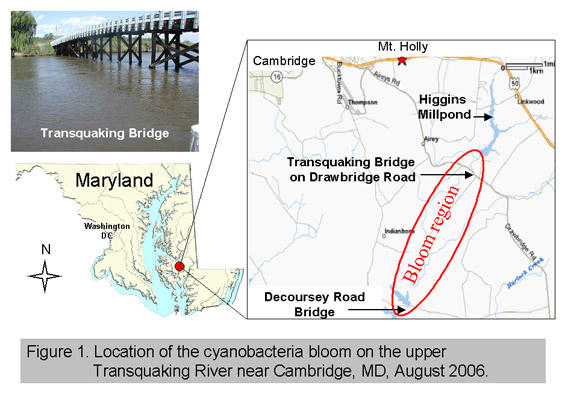|
||||||||||||||||||||||||||||||||||||||||||||||||||||||||||||||||||||||||||||||||||||
Maryland Department of Natural Resources (DNR) with Maryland Department of the Environment (MDE) and Maryland Department of Health and Mental Hygiene (DHMH) have identified algal blooms in tidewater tributaries through routine monitoring and investigations of citizen reports. Discolored waters associated with algal blooms have most recently been identified for the South River and Parker's Creek in Anne Arundel County , the Corsica River in Queen Anne's County and the Potomac River at Blossom Point (Charles County).
South River Brown waters were noted and samples collected by South River Riverkeeper Drew Koslow on Cape St. John and Church Creek. DNR field teams also collected a sample from Harness Creek on July 24. Among the algae, the non-toxic dinoflagellate Scrippsiella precaria was abundant in the surface water at Cape St. John (7,900 cells per milliliter) and Harness Creek (6,477 cells per milliliter), however the Church Creek sample (101,600 cells per milliliter) had more than 10 times the density of the other South River sites. Chester River Tributaries on the Chester River system are also being reported as brown or mahogany in color. The Corsica River has been discolored by non-toxic Scrippsiella dinoflagellates. On August 3, bloom conditions were detected in the surface water samples supported by Scrippsiella abundance of 18,415 cells per milliliter at Sycamore Point and 3,810 cells per milliliter at Cedar Point. Further, a sample collected by DNR Fisheries staff from Langford Creek on August 8 th in particular also had Scrippsiella in abundance with densities of 6,096 cells per milliliter. Parker's Creek- Deale, MD In Parker's Creek, town of Deale , black water and dead or dying fish and crabs in a crab pot were reported by Captain Jim Brincefield on July 29. DNR staff investigated and found an algal bloom in progress at the Rest Haven Community pier dominated by the non-toxic dinoflagellate Gyrodinium uncatenum and abundant flagellates. Living resource impacts are suspected due to the oxygen demand and related condition of the algae bloom and the inability of the fish and crabs to escape the intense, local phenomenon. The site was revisited on July 30 and showed brown water present but the intense black-colored water was no longer evident. Potomac River A Microcystis bloom (18,040 cells per milliliter) was recorded on July 26 from a water sample collected at DNR's Continuous Monitoring site at Blossom Point, mouth of the Nanjemoy River , Potomac River system. The results were complimentary to observations reported by fisherman Ken Penrod for the region last week. During spring, in concert with water quality forecasts for dissolved oxygen and submerged aquatic vegetation, a Microcystis bloom was forecast for this area of the Potomac River that would start by the end of July, last up to 2 months and stretch up to 20 miles at peak condition (see MASC Newsletter #5: https://www.eco-check.org/newsletters/ ). Bloom conditions will be tracked by DNR during the Chesapeake Bay Water Quality Monitoring Program for the remainder of the year to develop further comparisons with the forecast conditions. Transquaking River A diverse cyanobacteria (blue-green algae) bloom was sampled on the upper Transquaking River on August and contained abundant species such as Anabaena circinalis (maximum count 458,258 cells per milliliter at TRQ0210), Microcystis aeruginosa (115,214 cells per milliliter) and Cylindrospermopsis raciborskii (110,235 cells per milliliter) (Table 1, Figure 1). The Potomac and Transquaking River samples are being surveyed for toxins. Results are pending. Table 1. Cyanobacteria results from the Upper Transquaking River sampling locations, near Cambridge, MD. August 2, 2006 . Preliminary counts.
.* filament or colony Maryland Department of Natural Resources will continue to actively monitor and report on the condition of the river. Citizens are advised to take common precautions around bloom waters to reduce the possible risk of illness or discomfort related to blue-green algal blooms:
Please note that illness associated with harmful algal blooms is now a reportable illness so physicians should be reporting these to local health departments. The MD DNR in coordination and cooperation with DHMH and MDE will continue to monitor all blue-green algal blooms throughout the state. For up to date information on all of Maryland's harmful algal blooms and water quality, please visit Eyes on the Bay |
||||||||||||||||||||||||||||||||||||||||||||||||||||||||||||||||||||||||||||||||||||

